Reviews
C’era una volta il West
Sergio Leone
Italy / USA, 1968
Credits
Review by David Carter
Posted on 04 November 2011
Source Paramount DVD
Categories BRONSON!
It is unlikely that scholars and fans will ever reach a consensus on what film is “the greatest western of all time.” It is a discussion that has been held considerably longer than those for other genres because, though always prematurely, the western has been declared “dead” several times, with historians waiting in the wings to autopsy and assign values to the canon. The western was essentially a dead genre in 1964 when Sergio Leone released A Fistful of Dollars. Granted, production of westerns never ceased in America or Europe, but the commercial and—more importantly—artistic life of the “horse opera” was over. Leone’s “Man with No Name” trilogy breathed life into the western’s corpse, but it would not be his greatest contribution to the genre. Once Upon a Time in the West would become Leone’s masterpiece and a legitimate contender for a “greatest ever” title, regardless of genre.
Though quite enjoyable for the drama and action associated with the genre, Once Upon a Time in the West is a critic’s film; one for which deeper analysis only enhances its appeal. It is, by design, a synthesis of all westerns that preceded it. Leone tasked film critics-turned-directors Bernardo Bertolucci and Dario Argento to create a story that heavily referenced the masterworks of the genre. The result is a film that is both new and familiar; a synthesis of the elements that made High Noon, The Searchers, and Leone’s own films great. One gets the sense that Leone was quite intentionally trying to make a film that would be considered among the best and, unlike so many others who have tried, he succeeded.
Once Upon a Time in the West is simultaneously a rejection and subversion of the defining tropes of the western, however. Nowhere is this more evident than in the film’s lengthy pre-credit introduction. A trio of men arrive a nearly deserted train station. By their appearances and demeanor, the audience learns that they are villains, and the introduction marks the only time in the film that morality is presented unambiguously. Their quarry—the mysterious “Harmonica” (Charles Bronson)—arrives via train and soon engages in a three-on-one standoff. This scene is Once Upon a Time in the West’s own version of the classic western “test” scene, where the hero proves his mettle by beating seemingly impossible odds. Leone subverts this trope the moment guns are drawn and shots fired. Harmonica falls along with the villains, rising a brief moment later clutching a wounded arm. Leone is showing that the mythical western hero is just that, a myth, and that the characters in this film are all-too-human.
The main narrative of Once Upon a Time in the West sees several subplots intertwine and unravel, showing at once the interconnectivity and isolation of the characters. Harmonica has come to the town of Flagstone in search of gunfighter Frank (Henry Fonda) for reasons unknown, but doubtlessly involving revenge. Frank is currently in the employ of Morton, a railroad baron with his eye on a remote parcel of land called Sweetwater. Disguised as the jailed bandit Cheyenne, Frank lays siege to Sweetwater, murdering the owner and his three children. Later the same day, the owner’s bride, Jill, arrives from New Orleans to find her husband dead and herself the sole owner of a plot in the middle of nowhere. Meanwhile, Cheyenne escapes from captivity and forms an uneasy alliance with Harmonica, both of whom are looking for Frank. Together they investigate the scene at Sweetwater and take turns protecting the endangered Jill from Frank’s men but Jill, a former prostitute, is more than capable of holding her own against Frank.
Over the course of the film’s near three-hour running time, the principals form and break alliances with each another frequently, the implication being that they are somehow fated to be a part of one another’s lives. The concept of fate hangs heavily over the film and the purposely cast against type Fonda’s Frank most readily embodies this concept by representing the inevitability of death. The other characters can be analyzed in a similar manner. Though they have almost no scenes together, Jason Robards’ philosophical bandit Cheyenne is the counterbalance to Frank and represents the concepts of life and wisdom. Cheyenne takes the least active role of the four main characters and is primarily used to provide information and guidance to the others.
The concepts embodied by Harmonica and Jill are best seen in the film’s climax. Harmonica finally has his showdown with Frank and, in winning, comes to represent justice. It is a particular type of justice, however; the justice of the gun, “western justice.” This is a key concept to understanding Jill’s role at the film’s conclusion, where she comes to embody the concept of civilization. Jill expects Harmonica to stay with her but instead he opts to continue wandering. Leone is metaphorically representing the death of the mythic “Old West.” Frank’s death signals the end of lawlessness and the rule of the gun in the west. Though Harmonica is the only character shown in a positive light for the entirety of the film, it is clear that his brand of justice has no place in the new “civilized” west that Jill represents. To extend this image further, Cheyenne dies a non-violent death shortly thereafter. Cheyenne’s gradual passing is representative of the myths and lore of the Old West fading, and Leone shows its replacement in the film’s final image: the mechanical marvel of the locomotive arriving at the newly civilized Sweetwater under Jill’s care.
Thus Once Upon a Time in the West culminates with the end of the Old West. The remorseless killer and the noble bandit are dead, the only just and honest man has ridden off into the sunset alone, and the formerly immoral woman is redeemed by her decision to embrace the future. It was not the final film nor the final western Leone would make, but it is his zenith. In the maze of diverging subplots and the looming specter of the future, Charles Bronson emerges as the film’s anchor, perhaps because he is the only constant. In a film known for actors playing against type, Bronson fully embraces the stoic and mysterious persona for which he is best known. This would his only film with Leone, who wanted him for the Man with No Name role that went to Clint Eastwood. Bronson and Leone’s styles complemented each other so well that it should come as no surprise that Leone hailed Bronson as “the greatest actor I ever worked with.” Considering that Leone directed Eastwood, Lee Van Cleef, Eli Wallach, Henry Fonda, James Coburn, Rod Steiger, and Robert De Niro, that compliment shouldn’t be taken lightly.
More BRONSON!
-
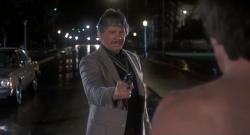
10 to Midnight
1983 -
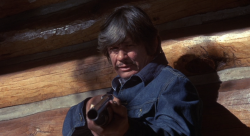
Mr. Majestyk
1974 -
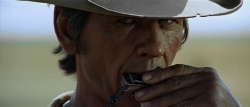
Once Upon a Time in the West
1968 -
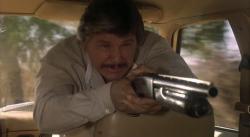
The Evil That Men Do
1984 -
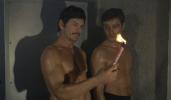
Farewell, Friend
1968 -
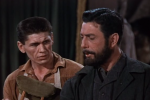
House of Wax
1953
We don’t do comments anymore, but you may contact us here or find us on Twitter or Facebook.



